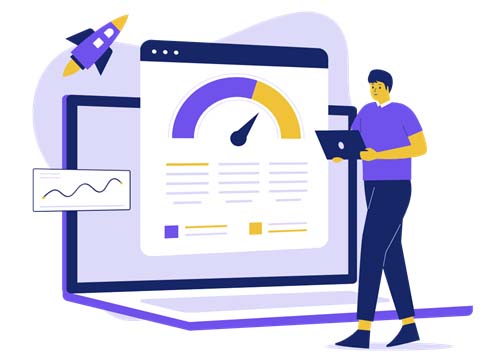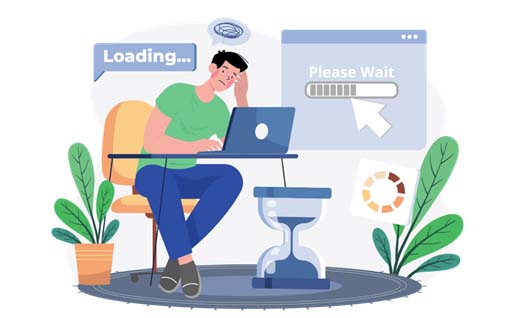What is page loading speed?
Page loading speed refers to the time it takes for a web page to load completely. Several factors influence page loading speed, including the server’s performance, the size of the page files, and the compression of images.

But “page loading speed” isn’t as simple as it sounds because there are various ways to measure it. Here are three common methods:
1. Fully Loaded Page: This measures how long it takes for every resource on a page to load. It’s a straightforward way to see how fast a page is.
2. Time to First Byte (TTFB): This measures the time it takes for a page to start loading. If you’ve ever waited on a white screen after clicking a link, you’ve experienced TTFB.
3. First Meaningful Paint/First Contextual Paint: This measures how long it takes for enough resources to load so that users can read the content. For example, if a blog post takes 10 seconds to fully load but shows readable content in 1.5 seconds, users can start interacting with the page almost immediately.
Each of these metrics provides a different perspective on page loading speed. For instance, even if a page takes 10 seconds to fully load, a fast First Meaningful Paint means users feel like the page is quick because they can start reading content almost right away.
There’s no single best way to measure page loading speed. Each method has its advantages and disadvantages. The goal should be to improve your page loading speed across all these metrics to enhance the overall user experience.
Importance of page loading speed in SEO
Page loading speed is crucial for SEO because it directly impacts user experience and search engine rankings. When a webpage loads quickly, visitors are more likely to stay and engage with the content. Conversely, if a page takes too long to load, users may become frustrated and leave, increasing the bounce rate and reducing the time spent on the site.

Imagine you walk into a fast-food restaurant, and it takes 10 minutes for someone to take your order. Chances are, you’d leave and find another place to eat. The same concept applies to websites. If a web page is slow, visitors will leave and may not come back. This is why search engines like Google prioritize fast-loading sites in their rankings. They want to provide users with the best possible experience, and fast websites are part of that equation.
For example, consider an online store selling shoes. If the product pages take too long to load, potential customers might leave before seeing what’s available. Even worse, they might abandon their shopping carts if the checkout page is slow, leading to lost sales. On the other hand, a fast-loading site can keep customers engaged, leading to higher conversion rates and sales.
Moreover, mobile users, who often have slower internet connections than desktop users, are particularly affected by page loading speed. If a site isn’t optimized for mobile speed, it can lose a significant portion of its potential audience.
In real life, think of page loading speed as the efficiency of a drive-thru. The faster you get your order, the happier you are. Similarly, the quicker a webpage loads, the happier and more likely users are to stay and engage. This makes page loading speed a critical factor for both user satisfaction and SEO success.
How core web vitals affect page loading speed?
Google’s Core Web Vitals are crucial metrics that help measure the user experience of a webpage. These metrics focus on loading speed, interactivity, and visual stability, giving you a comprehensive picture of your page’s performance. Here’s a breakdown:
1. Largest Contentful Paint (LCP): This measures how long it takes for the main content of your page to load. Ideally, it should be 2.5 seconds or less. A faster LCP means users see your content quickly, which keeps them engaged.
2. First Input Delay (FID): This measures how long it takes before a user can interact with your page (like clicking a button or a link). The target is 100 milliseconds or less. A low FID ensures your site responds swiftly to user actions, providing a smooth experience.
3. Cumulative Layout Shift (CLS): This measures how often users experience unexpected layout shifts. The goal is a CLS score of 0.1 or less. Reducing CLS prevents annoying content shifts that can cause users to click the wrong link or button.
You can see how your site scores on these metrics in the Core Web Vitals report in Google Search Console. Google categorises your site’s performance as “Good,” “Needs Improvement,” or “Poor.” It’s essential to aim for the “Good” category to avoid penalties from Google and ensure a positive user experience.
Remember, while optimizing for page loading speed is important, it shouldn’t come at the expense of good content. Google prioritizes relevance and search intent. So, focus on creating valuable content that meets users’ needs first.
To sum up, prioritize fixing pages with poor performance to avoid penalties from Google. Aim to meet the “Good” thresholds for Core Web Vitals to improve your page loading speed and user experience, but always ensure your content is relevant and valuable. For more detailed guidance, refer to our comprehensive guide on Core Web Vitals and how to enhance them.
Tools and resources
Monitoring your page load time is crucial for ensuring a fast and efficient user experience. Here are some user-friendly tools to help you check your website’s performance:
This free tool from Google gives you a detailed report on your website’s performance. It measures both mobile and desktop performance, providing insights on Core Web Vitals and offering suggestions for improvements. Think of it like a health checkup for your website, highlighting areas that need attention.
2. GTmetrix
GTmetrix is another popular tool that evaluates your page loading speed and provides a comprehensive report. It includes scores for performance and structure, as well as specific recommendations. It’s like getting a detailed car inspection report that tells you what needs fixing to run smoothly.
Pingdom’s tool is straightforward and easy to use. Enter your URL, choose a server location, and get a quick summary of your page’s load time, size, and the number of requests. It’s like checking your car’s speed with a quick test drive around the block.
WebPageTest allows you to run custom tests based on different user conditions, such as location and browser type. It provides a detailed waterfall graph showing how different elements load. Imagine running a race with different shoes to see which ones make you fastest—this tool helps you understand how different conditions affect your page load time.
While primarily an SEO tool, Semrush’s Site Audit feature also checks page loading speed and performance issues. It’s like having a multi-functional tool that not only fixes your car but also tunes it for optimal performance.
By using these tools, you can get a clear picture of how fast your site loads and what you can do to improve it, ensuring a smooth and speedy experience for your visitors.
Best practices
Improving page loading speed is essential for a better user experience and higher search engine rankings. Here are some best practices to help you achieve this:
Compress Images
Start with image compression because images usually take up 50-90% of a webpage’s size. Compressed images load faster and make your page quicker. For example, in a page loading speed report, 86.2% of the page size was due to images. If you use WordPress, a plugin like WP Smush can automatically compress images when you upload them, reducing their size by about 14.2%. If you don’t use WordPress, tools like Caesium and Mass Image Compressor can help. These modern tools use lossless compression or reduce quality in a way that’s barely noticeable.
Clean and Compress Your Code
Minifying your resources, such as HTML, CSS, and JavaScript, is another way to speed up your site. Remove any unnecessary or outdated code. Cleaner code means faster loading times. Then, use a program like GZip to compress your code, further speeding up your site.
Upgrade Hosting
No matter how well you optimize your site, if you’re using cheap hosting, your site won’t load quickly. Cheap hosting means sharing a server with many other websites, which slows down your site. Investing in a premium host or dedicated server can make a significant difference in loading times.
Activate Browser Caching
Browser caching allows users to store parts of your website in their browser cache. This makes subsequent visits to your site much faster. While it doesn’t speed up the first visit, it significantly improves loading times for repeat visitors. You can set this up in your .htaccess file or use a WordPress plugin.
Implement a CDN
A Content Delivery Network (CDN) can drastically improve loading times by serving your site’s resources from a server close to your visitor’s physical location. This reduces the distance data has to travel and speeds up the loading process.
Test With Multiple Tools
After making these improvements, test your page loading speed with different tools to see how well you’re doing. Google PageSpeed Insights is great for finding issues and opportunities to improve. It even reports real user data from Chrome. However, some recommendations might not be suitable for your site, so use your judgement.
Another tool is WebPageTest.org, which loads your page in an actual browser and identifies specific parts of your page that are slow. Using both tools gives you a comprehensive view of your site’s performance.
By following these steps, you can significantly improve your page loading speed, providing a better experience for your users and boosting your SEO rankings.
Conclusion
Page loading speed is crucial for a good user experience and can significantly impact your site’s SEO. Slow-loading pages can frustrate visitors and lead them to leave your site quickly, much like how long lines at a store can drive customers away. To keep your site running smoothly, regularly check its load time using tools like Google PageSpeed Insights, GTmetrix, Pingdom, WebPageTest, and Semrush Site Audit.
Each tool offers unique insights, so using a combination can give you a comprehensive understanding of your site’s performance. By following the recommendations from these tools, you can make necessary adjustments to improve speed, such as compressing images, reducing HTTP requests, and optimizing code. Remember, a faster website not only keeps visitors happy but also helps your site rank better in search engines. Keep your site in top shape, just like maintaining a well-oiled machine, for the best results.